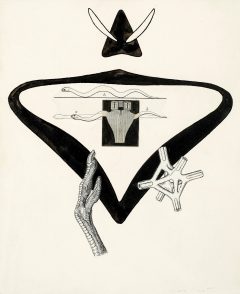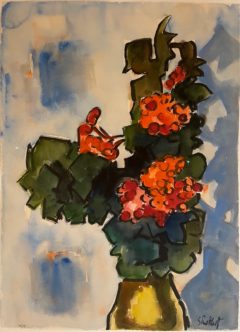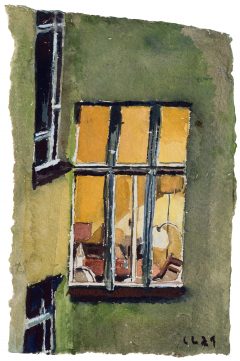Max Ernst
Soleil jaune
1964

Oil on canvas
65 × 53 cm / 25 9/16 × 20 7/8 in
Signed and "64" dated also verso titled
Catalogue Raisonné by Spies/Metken/Pech no. 3851
Price includes German VAT. Shipping costs are not included. All prices are subject to change and availability. Change region and currency
Alexander Iolas Gallery, New York; Private Collection USA; Hauswedell & Nolte (December 1999); Private Collection Germany
- Galerie Ludorff, "50 Jahre", Part I, 4. Apr. - 7. Jun., Düsseldorf 2025
- Galeria René Metras, "Max Ernst", Barcelona 1968
- Palazzo Grassi, "Max Ernst. Oltre la pittura", Venedig 1966
- The Jewish Museum, "Max Ernst. Sculpture and recent paintings", New York 1966
- Hanover Gallery, "Max Ernst. Early and recent paintings and sculpture", London 1965
- Galerie Ludorff, "50 Jahre", Part I, Düsseldorf 2025, S. 23
- Werner Spies/Sigrid & Günter Metken/Jürgen Pech, "Max Ernst Œuvre-Katalog Werke 1964-1969", Houston/Köln 2007, no. 3851
- Galeria René Metras (Hg.), "Max Ernst", Barcelona 1968, no. 8
- Sam Hunter (Hg.), "Max Ernst. Sculpture and recent painting", Ausst.-Kat. The Jewish Museum, New York 1966, no. 63
- Centro Internazionale delle Arti e del Costume (Hg.), "Max Ernst. Oltre la pittura", Ausst.-Kat., Venedig 1966, no. 62
- Hanover Gallery (Hg.), "Max Ernst. Early and recent paintings and sculpture", London 1965, no. 41
Looking at Max Ernst's painting "Soleil jaune" evokes many associations. Each of us will see the yellow sun disk from a different angle, for example through a window glass partially scratched free by the ice or surrounded in the cosmic fog by the rays of its halo. Ultimately, however, a certain interpretation is not possible, nor is it intended by the artist.
He makes it quite clear that anyone can interpret his works as he likes, but this should not be done rationally, because it would defuse them. Just as we can project a face and then an animal into a formless cloud in the sky, Max Ernst wants to trace the ambivalence of natural phenomena in his art. He is constantly searching for the hidden contradictoriness behind the principle of the identity of a being or an object - nothing is final and closed for him. As a result, he also withdraws his pictorial world from the definitive, authoritarian, once-founded judgment. From this fragility and changeability the artist draws the poetry of his enigmatic works. In his fantastic depictions, Max Ernst refers to ambiguity not only on the level of content.
From the beginning of his work he included artistic techniques. He experimented with them with great openness, always assuming the existence of banal objects. These always inspire him to create new constellations and encourage him to take still unknown approaches. One such is the Grattage, which Max Ernst developed for painting in a variation of the rubbing and rubbing process of frottage: As in our work, he first applies several layers of paint, here yellow and green, one on top of the other. Then he randomly places things with different surfaces under the canvas. With a painting knife he now scrapes off the squeezed out parts, so that the deeper layers of colour become visible.
He does this intuitively or consciously under sometimes weak, sometimes stronger pressure of his hand, while not ignoring chance. He persistently repeats this procedure until he finally reworks the structures obtained in this way with a brush, raises some parts with white and highlights individual scratch marks with dark green. In this way, the artist explores the secret that lies in the things and textures themselves and that leads them to each other in unforeseen encounters and mergers. At the same time, he never gives the small structures an abstract meaning alone. They always remain bound to the representational and thus contain something of reality.
What Max Ernst describes is the experience that leads him to fill spots with figurations and landscapes. And what he creates is a grandiose idea of a possible but inaccessible world - this is where his feeling for nature expresses itself most strongly. But as already mentioned, he does not describe a final state. Rather, it represents a starting point. Only when we look at the "Soleil jaune" does the painterly result begin to unfold and take effect in us: We follow the sensualistic appeal that emanates from the many microforms. These always keep our eyes in motion and only briefly can they "hold on" to the colour relief. As an active creator, Max Ernst has receded into the background; he merely remains the controlling and critically supervising authority that carefully directs our visual experience.






